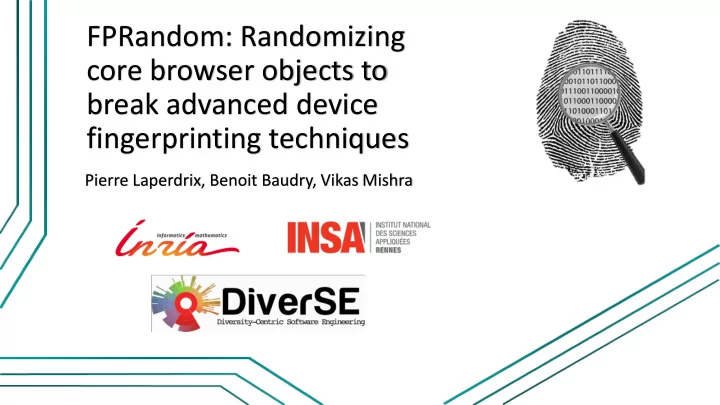

FPRandom: Randomizing core browser objects to break advanced device fingerprinting techniques Pierre Laperdrix, Benoit Baudry, Vikas Mishra
Outline 1) What is fingerprint-based tracking? 2) Randomizing core browser objects a. Generating instability b. Example n ° 1: Ordering of JavaScript properties c. Example n ° 2: Canvas fingerprinting 3) Evaluation and conclusion 2/22
3/22
AmIUnique.org • Launched in November 2014 • 400,000+ fingerprints collected so far 4/22
Example of a fingerprint Attribute Value User agent Mozilla/5.0 (X11; Fedora; Linux x86_64; rv:54.0) Gecko/20100101 Firefox/54.0 HTTP headers text/html,application/xhtml+xml,application/xml;q=0.9,*/*;q=0.8 gzip, deflate, br en-US,en;q=0.5 Plugins Plugin 1: QuickTime Plug-in 7.6.6; libtotem-narrowspace-plugin.so; Plugin 2: Shockwave Flash 26.0 r0; libflashplayer.so Fonts Century Schoolbook, Source Sans Pro Light, DejaVu Sans Mono, Bitstream Vera Serif, URW Palladio L, Bitstream Vera Sans Mono, Bitstream Vera Sans, ... Platform Linux x86_64 Screen resolution 1920x1080x24 Timezone -480 (UTC+8) OS Linux 4.11.5-200.fc25.x86_64 WebGL vendor NVIDIA Corporation WebGL renderer GeForce GTX 650 Ti/PCIe/SSE2 Canvas 5/22
Can we be tracked? • 94.2% of collected Browser Screen fingerprints are resolution unique (2010) OS • 89.4% of collected Fonts fingerprints are unique (2016) • Smartphones are Timezone also prone to Plugins fingerprinting 6/22
Outline 1) What is fingerprint-based tracking? 2) Randomizing core browser objects a. Generating instability b. Example n ° 1: Ordering of JavaScript properties c. Example n ° 2: Canvas fingerprinting 3) Evaluation and conclusion 7/22
Proposed defense: making attributes unstable for tracking • Most attributes in a fingerprint are predictable and do not drastically change over time • Normal evolution behavior • Desired evolution behavior How? 8/22
Creation of multiple execution paths Result n ° 1 Result n ° 2 Result n ° 3 Result n ° 4 Parameters Result n ° 5 Execution Result n ° 6 path Result n ° 7 Result n ° 8 Result n ° 9 Execution path 9/22
Two approaches 1. Remove the determinism of specific browser functions Production of different results 2. Alter the rendering of multimedia elements Production of different renderings 10/22
Example n ° 1: Ordering of JavaScript properties • Special JavaScript objects have their own enumeration order. • Navigator object • Firefox “ vibrate;javaEnabled;getGamepads;mozGetUserMedia;requestMediaKeySystemAccess;regist erProtocolHandler;registerContentHandler;taintEnabled;permissions;mimeTypes;plugins;doN otTrack;oscpu;vendor;vendorSub;productSub[…]” • Chrome “vendorSub;productSub;vendor;maxTouchPoints;hardwareConcurrency;cookieEnabled;appCo deName;appName;appVersion;platform;product;userAgent;language;languages;onLine;doNo tTrack;geolocation;mediaDevices;plugins[…]” Browser can be unmasked 11/22
Example n ° 1: Ordering of JavaScript properties • The JavaScript language follows the ECMAScript specification. • Section 13.7.5.15 “mechanics and order of enumerating the properties is not specified” Provide protection by randomizing the enumeration order 12/22
Example n ° 1: Ordering of JavaScript properties • First change We activate the “JS_MORE_DETERMINISTIC” flag. Latin-1 Character Code point Result 1 2 3 4 ‘a’ 97 a p p V e r s i o n 0 1 ‘a’ 97 ‘p’ 112 3 0 2 ‘p’ 112 a p p N a m e appVersion > ‘V’ 86 4 8 appName ‘N’ 78 13/22
Example n ° 1: Ordering of JavaScript properties • Second change We change the string comparison function. Latin-1 Character Code point Result 1 2 3 4 appVersion > ‘V’ 86 a p p V e r s i o n 4 8 appName ‘N’ 78 a p p N a m e Random Boolean: Yes or No 14/22
Example n ° 1: Ordering of JavaScript properties • Generation of a Boolean for every possible combination of the Latin-1 character set • Creation of a random enumeration order for each session Prevent trackers from using this technique by creating unstable orders 15/22
Example n ° 2: Canvas fingerprinting • Canvas API to draw shapes and render strings • Depends on both hardware and software Send JavaScript script Receive canvas result 16/22
Example n ° 2: Canvas fingerprinting 1 2 3 17/22
Example n ° 2: Canvas fingerprinting • Two changes Apply very small modifications when parsing a new color canvas.Context.fillStyle = “rgba(102, 204, 0, 0.7)” ; “rgba(103, 203, 0, 0.7)” ; Chose a random font canvas.Context.font = “18pt Arial” ; “18pt Times New Roman” ; 18/22
Example n ° 2: Canvas fingerprinting Prevent trackers from using this technique by creating random canvas renderings 19/22
Outline 1) What is fingerprint-based tracking? 2) Randomizing core browser objects a. Generating instability b. Example n ° 1: Ordering of JavaScript properties c. Example n ° 2: Canvas fingerprinting 3) Evaluation and conclusion 20/22
Evaluation • 25% increase in execution time for modified functions • User study Very small impact on the user experience Improvements needed on the selection of fonts • Crawl of the top 1,000 Alexa websites No visible breakage No noticeable change in loading times 21/22
Conclusion • With FPRandom, we break the stability of the following attributes: the enumeration order of special JS objects, Canvas fingerprinting and AudioContext fingerprinting. • Two different approaches Remove the determinism of specific browser functions by exploiting the JavaScript specification Alter the rendering of multimedia elements • Future work: modify additional APIs to preemptively improve user’s privacy 22/22
Recommend
More recommend